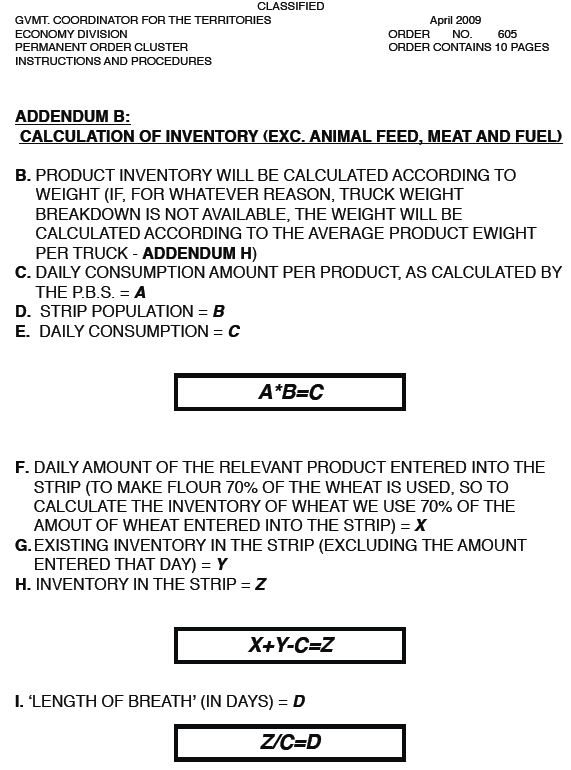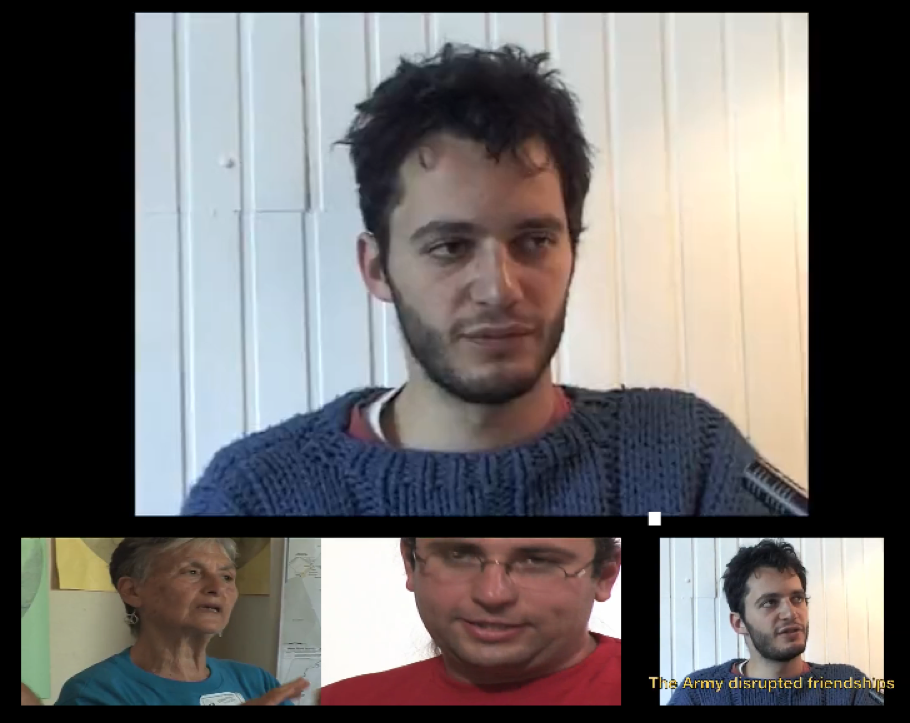The Only Democracy? » Featured » The mathematics of strangulation of Gaza
The mathematics of strangulation of Gaza
By Jesse Bacon
When the specifics of Israel’s siege of Gaza came to light, it appeared almost random in its insanity and cruelty. The famous example is the prohibiting of pasta while allowing rice, all the while claiming this was somehow ensuring Israel’s security. Well wonder no longer. Through the heroic efforts of Gisha, whose work we feature regularly here on The Only Democracy?, the actual policy has been released. It turns out there is a detailed series of charts and formulae that look like someone attempted to translate the lectures of Glenn Beck into public policy. In the driest of terms, it represents a calculus of human misery, equations of despair that add up to the starvation of Gazans and a protracted conflict.
Here is Gisha’s summary of the revealed policy, with my annotations.
“Policy of Deliberate Reduction”The documents reveal that the state approved “a policy of deliberate reduction” for basic goods in the Gaza Strip (section h.4, page 5*). Thus, for example, Israel restricted the supply of fuel needed for the power plant, disrupting the supply of electricity and water. The state set a “lower warning line” (section g.2, page 5) to give advance warning of expected shortages in a particular item, but at the same time approved ignoring that warning, if the good in question was subject to a policy of “deliberate reduction“. Moreover, the state set an “upper red line” above which even basic humanitarian items could be blocked, even if they were in demand (section g.1, page 5). The state claimed in a cover letter to Gisha that in practice, it had not authorized reduction of “basic goods” below the “lower warning line”, but it did not define what these “basic goods” were (page 2).
So, the lower red line is to tell Israel that its policies were working as designed to cause shortages, thus allowing them to “ignore” the warnings. Even at the upper limit, Israel could keep denying goods if it saw fit to do so. I am reminded of one of those thermometers used to measure fundraising, only here the goal is deprivation not development.
“Luxuries” denied for Gaza Strip residentsIn violation of international law, which allows Israel to restrict the passage of goods only for concrete security reasons, the decision whether to permit or prohibit an item was also based on “the good’s public perception” and “whether it is viewed as a luxury” (section c.b, page 16). In other words, items characterized as “luxury” items would be banned – even if they posed no security threat, and even if they were needed. Thus, items such as chocolate and paper were not on the “permitted” list. In addition, officials were to consider “sensitivity to the needs of the international community”.
Secret List of GoodsThe procedures determine that the list of permitted goods “will not be released to those not specified!!” (emphasis in original) (section j, page 17), ignoring the fact that without transparency, merchants in Gaza could not know what they were permitted to purchase. The list itemized permitted goods only. Items not on the list – cumin, for example – would require a special procedure for approval, irrespective of any security consideration, at the end of which it would be decided whether to let it in or not.
Ban on Reconstructing GazaAlthough government officials have claimed that they will permit the rehabilitation of Gaza, the documents reveal that Israel treated rehabilitation and development of the Gaza Strip as a negative factor in determining whether to allow an item to enter; goods “of a rehabilitative character” required special permission (section g, page 16). Thus, international organizations and Western governments did not receive permits to transfer building materials into Gaza for schools and homes.
Calculation of product inventoryThe documents contain a series of formulas created by the Defense Ministry to compute product inventory (pages 8-10). The calculations are presumed to allow COGAT to measure what is called the “length of breath” (section i, page 8). The formula states that if you divide the inventory in the Strip by the daily consumption needs of residents, you will get the number of days it will take for residents of Gaza to run out of that basic product, or in other words, until their “length of breath” will run out.
According to Gisha Director Sari Bashi: “Instead of considering security concerns, on the one hand, and the rights and needs of civilians living in Gaza, on the other, Israel banned glucose for biscuits and the fuel needed for regular supply of electricity – paralyzing normal life in Gaza and impairing the moral character of the State of Israel. I am sorry to say that major elements of this policy are still in place“.
The data[on availability of items] will be collected in the economy division, once a week, on Tuesday, and a calculation compiled of products transferred, then added to existing inventories, and then consumed amounts will be deducted according to the models.
F.# After the calculation is performed, a draft of inventory estimates will be prepared…[and] the following data will be checked:
# 1. Upper level warning – in case inventory of one of the short shelf life products is over 21 days or long shelf life product inventory is over 80 days.
# 2. Lower level warning – in case inventory of one of the short shelf life products is under 4 days or long shelf life product inventory is under 20 days.
# 3. Shortage – in case inventory of one of the short shelf life products is under 2 days or long shelf life product inventory is under 5 days.
H. In case inventory of one or more products reached a ‘level of warning,’ the following actions will be taken:
1. Xxxx will verify the information with leading Palestinian merchants.
2. Xxxx will perform mathematical evaluation of the model to verify the data.
3. In case of an upper level warning, the issue will be brought up for discussion and update for a decision on policy of entering the # relevant product.
4.! In case of a lower level warning an update will be transferred, and Gaza DCO will take action to facilitate transferring the relevant product, unless it is an intentional policy of reduction. [ed., italics mine]
5. In case of shortage, the same actions as of ?lower level warning? will be taken. In case it is an intentional policy of reduction, decision makers will be presented with the consequences of shortage of the relevant product.
One wonders what warning the decision makers would be presented with: would they be warned that preventing entrance of a piece of medical equipment would cause the death of children? Or that the categorization of milk, or hummus or any number of staples of the Palestinian diet as “superfluous” might exacerbate the already existent malnutrition among children? Or that a shortage of fuel and hence water outages would cause women not to be able to cook properly or families to observe hygienic practices. What type of discussion do you think happened among the decision makers when they were ‘warned’ about these red lines?
Filed under: Featured · Tags: Gaza, Gisha, Kafka, mathematics, Richard Silverstein, Siege









 “You have a choice! Israeli Anti-Militarists Speak”
“You have a choice! Israeli Anti-Militarists Speak”